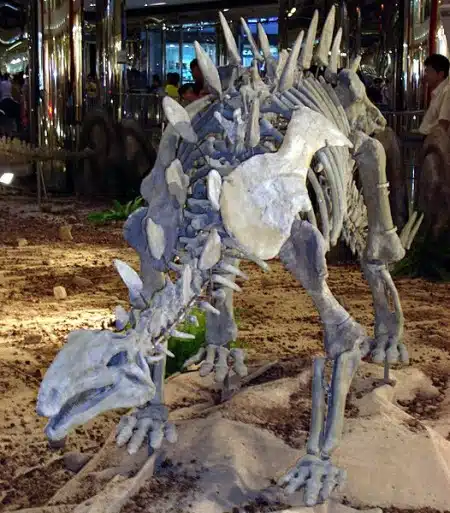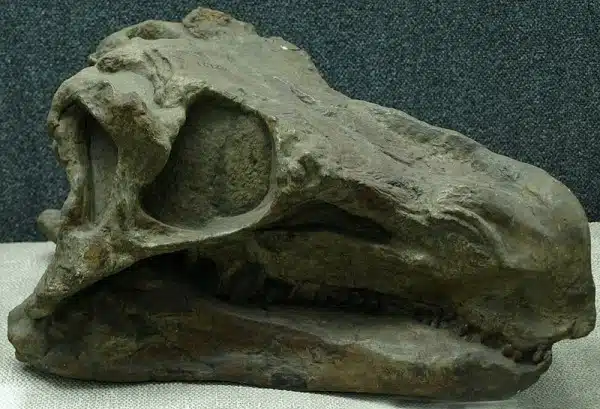When we delve into the realm of dinosaurs, Huayangosaurus stands out as a fascinating subject. Discovered in the lush, mountainous region of Sichuan, China, this dinosaur offers a unique window into the Middle Jurassic Period, a time spanning from 170.3 to 157.3 million years ago. The name Huayangosaurus, meaning “Huayang Lizard,” pays homage to its place of discovery, Huayang being an alternate name for Sichuan. This intriguing creature, belonging to the Stegosauria, was a herbivore, navigating its environment with a distinct set of physical and behavioral traits.
Huayangosaurus Key Facts
| Keyword | Fact |
|---|---|
| Pronunciation | hoy-YANG-oh-SORE-u |
| Meaning of name | Huayang Lizard |
| Group | Stegosauria |
| Type Species | Huayangosaurus taibaii |
| Diet | Herbivore |
| When it Lived | 170.3 to 163.5 MYA |
| Period | Middle Jurassic |
| Epoch | Bajocian to Callovian |
| Length | 13.0 feet |
| Height | 4.5 feet |
| Weight | 1,100.0 pounds |
| Mobility | Moved on all four |
| First Discovery | 1979 by Chinese Paleontologists |
| Described by | 1982 by Dong Zhiming, Tang Zilu and Zhou Shiwu |
| Holotype | IVPP V6728 |
| Location of first find | Dashanpu Quarry, Zigong, Sichuan, China |
Huayangosaurus Origins, Taxonomy and Timeline
Huayangosaurus, a name that resonates with the rich cultural and geographical heritage of China, specifically the Sichuan, is more than just a name. It’s a nod to the ancient land where it once roamed. The term ‘Huayang’ is an alternate name for Sichuan, and ‘saurus’ is derived from the Greek word for lizard or reptile. This nomenclature not only identifies the dinosaur but also connects it to its geographical roots.
In the grand tapestry of dinosaur classification, Huayangosaurus holds a unique position. It belongs to the Stegosauria, a collection of armored dinosaurs known for their distinctive plates and spikes. Within this group, it is classified under the Huayangosaurid family, with Huayangosaurus taibaii as its type species. This classification helps paleontologists understand its evolutionary relationships and distinct characteristics within the broader dinosaur family tree.

The timeline of Huayangosaurus is a journey back to the Middle Jurassic Period, specifically from the Bajocian to the Callovian. This era, spanning 170.3 to 163.5 million years ago, was a time of significant geological and biological changes. The presence of Huayangosaurus during this period provides valuable insights into the environmental and ecological dynamics of that era.
Listen to Pronunciation
Listen to the pronunciation of Huayangosaurus in this video.
Discovery & Fossil Evidence

The story of Huayangosaurus discovery is quite remarkable. Back in 1979 and 1980, a significant find occurred at the Dashanpu Quarry near Zigong in Sichuan, China. Here, remains from twelve individual stegosaurians were unearthed, providing a treasure trove of information for paleontologists. These remains were named and described in 1982 by Dong Zhiming, Tang Zilu and Zhou Shiwu. The type species, Huayangosaurus taibaii, was named in honor of the region (Huayang, an old name for Sichuan) and the great Chinese poet Li Bai, whose courtesy name was Taibai.
The main specimen, known as the holotype IVPP V6728, was particularly notable. It was discovered in a layer of the Shaximiao Formation, dating back to the Bathonian-Callovian period. This partial skeleton included a relatively complete skull, various vertebrae from different parts of the spine, a couple of metatarsals, phalanges, plates, a spike, and additional osteoderms. This comprehensive set of remains provided a detailed look at the anatomy of Huayangosaurus.
Several other specimens were also referred to Huayangosaurus initially, including more complete skeletons and various bones. However, in 2006, a review by Susannah Maidment, Guangbiao Wei and David B. Norman led to a reevaluation. Some specimens, due to lack of distinguishing features or significant differences, were no longer considered part of Huayangosaurus. This reclassification is a common occurrence in paleontology as new information and analyses come to light.

For those interested in seeing Huayangosaurus up close, mounted skeletons are on display at the Zigong Dinosaur Museum in Zigong and the Municipal Museum of Chongqing in Sichuan Province, China. These exhibits provide a fascinating glimpse into the life of this ancient creature, allowing us to marvel at a species that roamed the earth millions of years ago.
Huayangosaurus Size and Description
Huayangosaurus, a Stegosauria, presents a captivating image of jurassic life. This quadrupedal herbivore, with its small skull and spiked tail, is a testament to the diverse adaptations of dinosaurs. Its most striking feature, akin to its famous relative Stegosaurus, is the double row of plates rising vertically along its arched back. However, in Huayangosaurus, these plates were more spike-like, adding a unique touch to its appearance.
The defensive capabilities of Huayangosaurus were notable. It possessed a range of osteoderms (bony deposits forming scales, plates, or other structures in the skin) along its neck, back, and tail. These included small vertical plates and spikes arranged in pairs. The rear of its tail featured pairs of spikes, forming a structure known as the “thagomizer,” a formidable defensive weapon. Additionally, each flank of Huayangosaurus was adorned with a row of smaller osteoderms, culminating in a long, rear-curving shoulder spine, further emphasizing its armored nature.
Size and Weight of Type Species

Huayangosaurus was relatively small for a stegosaurian, measuring approximately 13.0 feet in length. In terms of body mass, it weighed around 1,100.0 pounds. This size places Huayangosaurus among the smaller members of its group, contrasting with some of its larger relatives. Despite its smaller stature, the combination of its armored plates, spikes, and the thagomizer at the tail end made it a well-equipped herbivore, capable of defending itself effectively in its environment.
Contemporary Dinosaurs
Imagine a world where the Huayangosaurus, a spiky, medium-sized stegosaur, roamed the ancient landscapes. This unique dinosaur, with its rows of bony plates and spikes, was a sight to behold. In its time, it shared the land with several fascinating contemporaries, each playing a distinct role in the ecosystem.
One of its neighbors was the Shunosaurus, a relatively smaller sauropod known for its distinctive clubbed tail. While Huayangosaurus busied itself nibbling on low-lying plants, Shunosaurus, with its longer neck, reached for higher foliage. This natural division of the dining menu meant that despite their coexistence, direct competition for food was minimal. They were like two chefs in a vast, jurassic kitchen, each expertly preparing different dishes.
Then there was Omeisaurus, another sauropod, but this one was larger than both Huayangosaurus and Shunosaurus. Its towering presence was a constant reminder of the diversity in size and strength among these ancient giants. Omeisaurus, with its immense size, likely had its pick of the forest canopy, a dining area too high for our spiky friend. This difference in feeding zones not only reduced competition but also painted a picture of a multi-layered ecosystem where each creature, big or small, had its place.
Interesting Points about Huayangosaurus
- Huayangosaurus is one of the earliest known members of the Stegosauria, providing crucial insights into the evolution of this distinctive family of dinosaurs.
- The discovery of Huayangosaurus in Sichuan, China, highlights the global distribution of dinosaurs and the rich paleontological significance of the region.
- Huayangosaurus’s unique physical characteristics, such as its specific body shape and locomotion, set it apart from other stegosaurs and reflect its adaptation to its environment.
- The well-preserved fossils of Huayangosaurus, including the holotype IVPP V6728, offer a detailed view of its anatomy and lifestyle.
- Huayangosaurus’s presence in the Middle Jurassic Period provides valuable information about the ecological and environmental conditions of that era.
Huayangosaurus in its Natural Habitat
The world of Huayangosaurus was a tapestry of diverse landscapes and climates, characteristic of the Middle Jurassic Period. The environment in which it lived was likely lush and verdant, with a variety of vegetation that supported its herbivorous diet. The geography of its habitat, with its unique features and resources, played a crucial role in the lifestyle and survival of Huayangosaurus.
As a herbivore, Huayangosaurus’s diet was primarily composed of plants. Its physical structure, particularly its teeth and digestive system, was well-suited to processing vegetation. The way it moved, on all four legs, suggests a stable and efficient means of navigating its environment, whether it was foraging for food or interacting with other species. The diet and locomotion of Huayangosaurus are key aspects of its adaptation to its habitat.
The social behavior of Huayangosaurus, whether it was a solitary creature or lived in herds, remains a topic of interest. Its interactions with other species, both as a potential prey and as part of the broader ecosystem, offer insights into the dynamics of its natural habitat. The role of Huayangosaurus in shaping the landscape and ecosystem of its time is a fascinating aspect of its existence, reflecting the interconnectedness of life in the jurassic world.
Frequently Asked Questions
It means “Huayang Lizard,” with Huayang being an alternate name for Sichuan, the province in China where it was discovered.
It was first discovered in 1979 and 1980 by a team of Chinese Paleontologists in the Dashanpu Quarry, Zigong, Sichuan, China.
It was a herbivore, primarily feeding on plants.
It lived during the Middle Jurassic Period, approximately 170.3 to 163.5 million years ago.
The fossils include well-preserved skeletal remains, providing detailed insights into its anatomy and lifestyle.
It moved on all four legs, indicating a stable and sturdy gait.
Sources
The information in this article is based on various sources, drawing on scientific research, fossil evidence, and expert analysis. The aim is to provide a comprehensive and accurate overview of Huayangosaurus. However, please be aware that our understanding of dinosaurs and their world is constantly evolving as new discoveries are made.
This article was last fact-checked: Joey Arboleda, 11-29-2023
Featured Image Credit: Nobu Tamura, CC BY 3.0 https://creativecommons.org/licenses/by/3.0, via Wikimedia Commons
